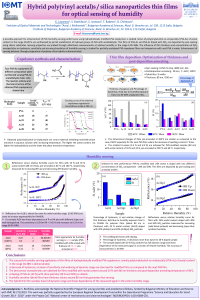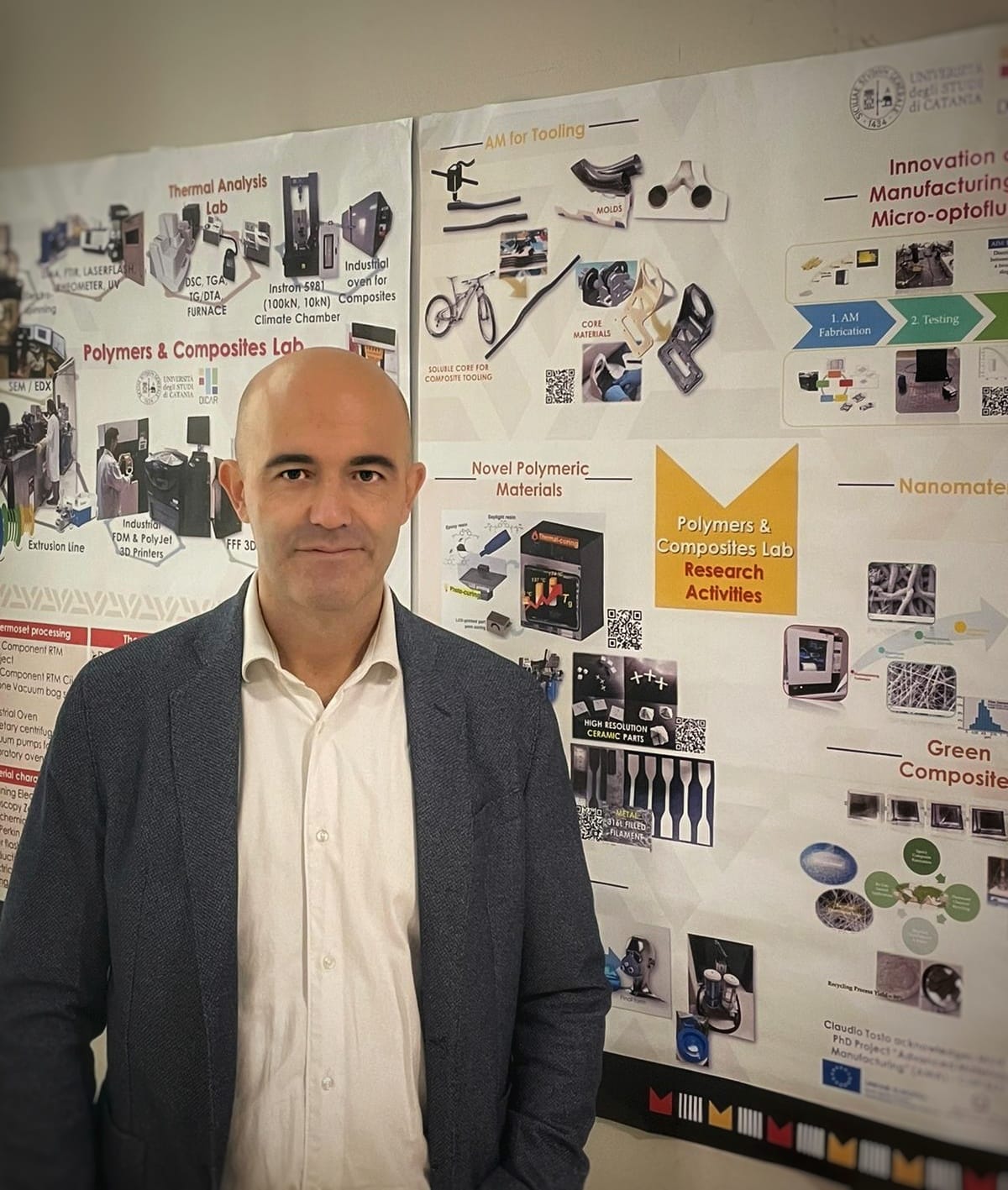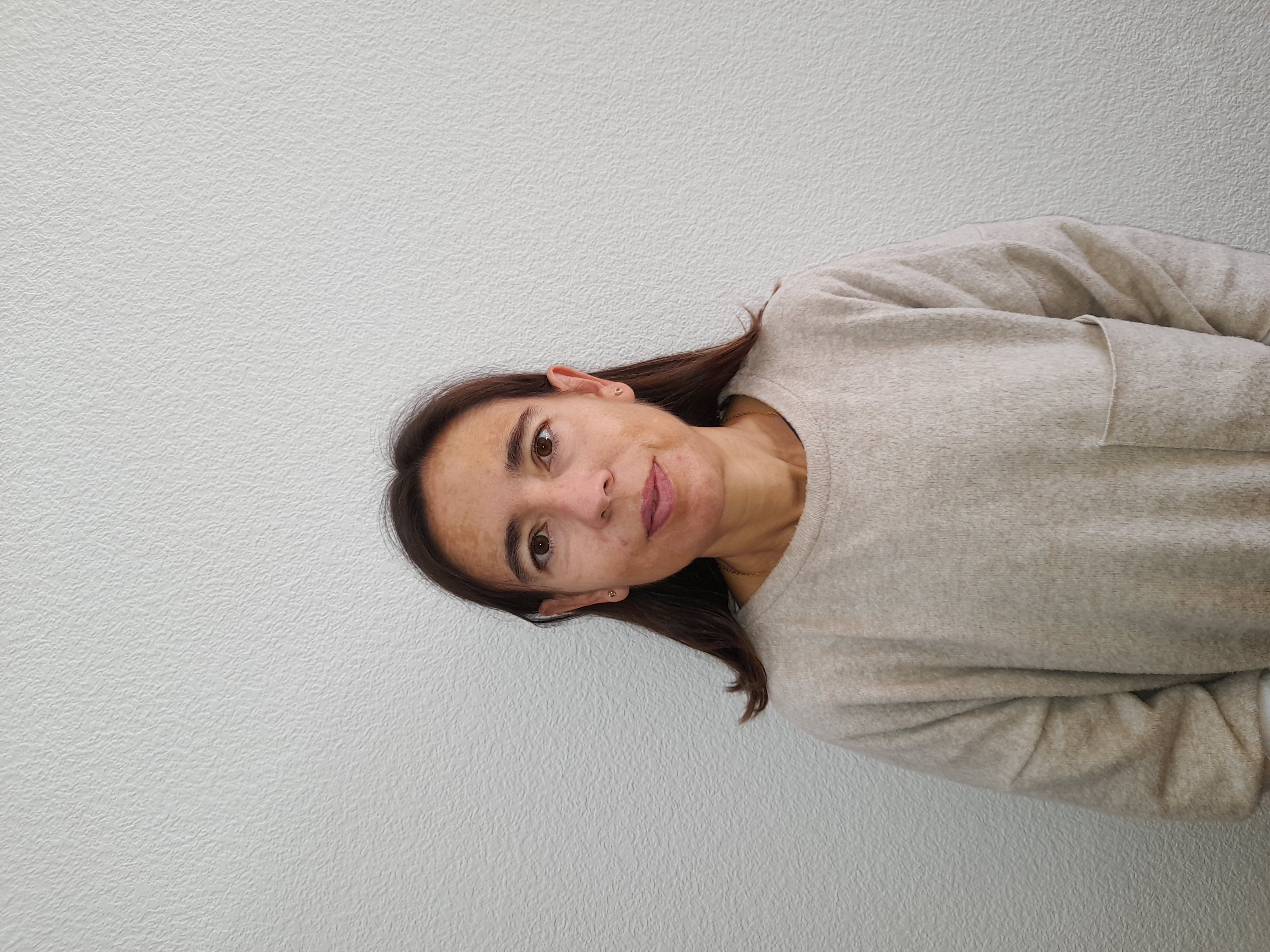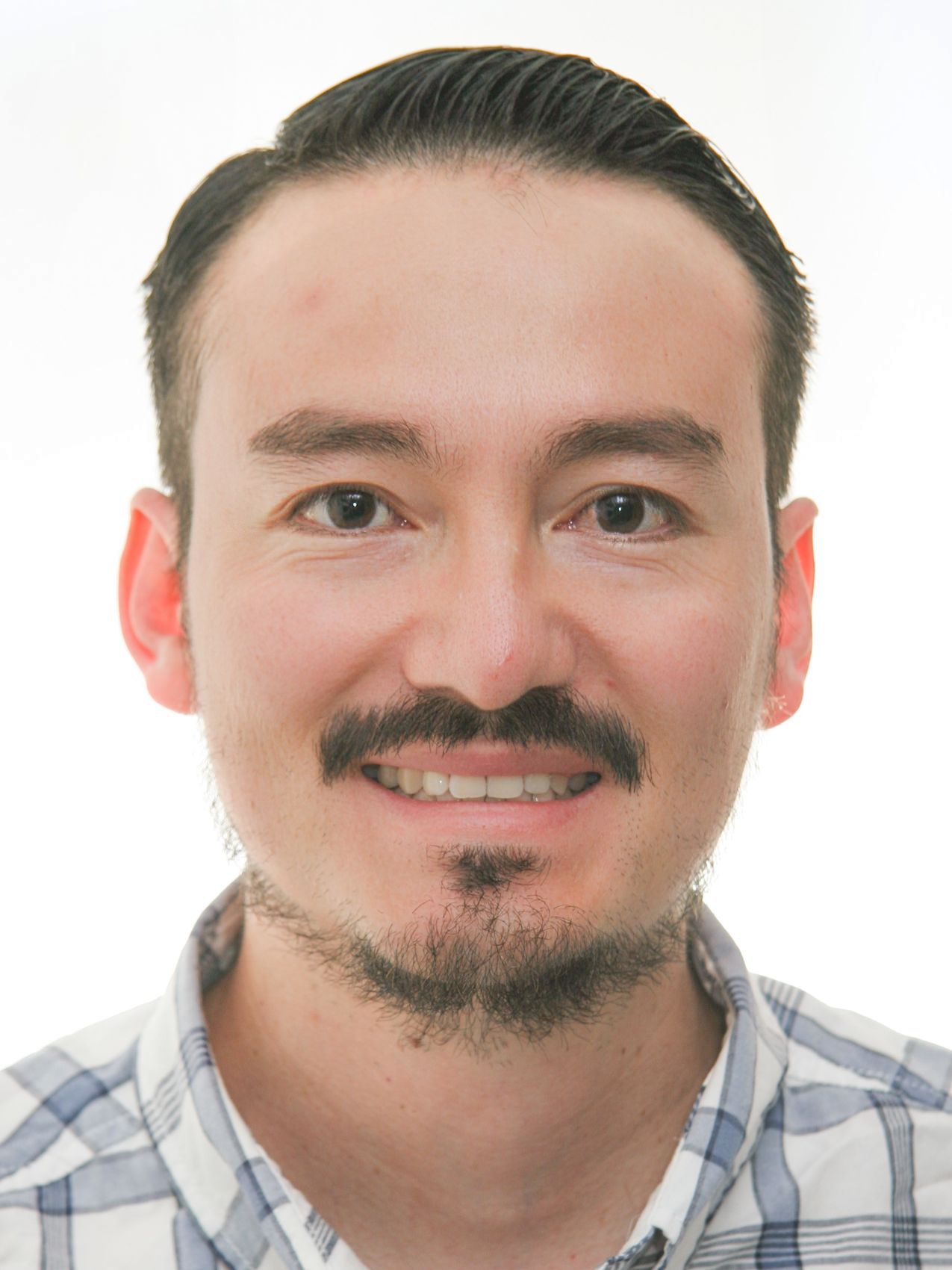
The 2nd International Online Conference on Polymer Science
Polymers and Nanotechnology for Industry 4.0
Part of the International Online Conference on Polymer Science series
1–15 November 2021
Smart Polymer, Additive Manufacturing, nanotechnologies, Functional biopolymers, Polymer recycling, Industry 4.0
- Go to the Sessions
-
- A. Smart polymeric Synthesis and Modification for Industry 4.0
- B. Polymer Development for Additive Manufacturing
- C. Advanced Functional Testing of Polymeric Materials
- D. Nanotechnologies in Polymer Science
- E. Biotechnologies and Functional Biopolymers
- F. Applications polymers in the Industry 4.0
- G. Polymer recycling
- Event Details
-
- Best Paper Awards Winners Announcement
- Best Presentation Awards Winners Announcement
- IOCPS 2021 is Closed Now!
- IOCPS 2021 | Live Session
- IOCPS 2021 | Live Session Recording
- Welcome from the Chairs
- Conference Chairs
- Session Chairs
- Sessions
- Instructions for Authors
- List of Accepted Submissions
- Sponsors and Partners
- Events in series IOCPS
Best Paper Awards Winners Announcement

The 2nd International Online Conference on Polymer Science—Polymers and Nanotechnology for Industry 4.0 established the Best Paper Awards to acknowledge the support of conference participants and to recognize their outstanding scientific accomplishments. Nominated candidates are selected by the committees based on the rigor of their science, the significance of their contribution to the field, and the originality of their work. The Best Paper Award winners are as follows:
Title: Hyaluronic Acid Hydrogel Particles Obtained Using Liposomes as Templates
by Irene Abelenda Núñez, Ramón G. Rubio, Francisco Ortega, Eduardo Guzmán
https://sciforum.net/paper/view/11222
Title: Light-driven Integration of Graphitic Carbon Nitride into Porous Polymer Networks
by Cansu Esen
https://sciforum.net/paper/view/11590
Each winner will receive a cash award of 300 CHF and an award certification. We look forward to posting your contributions.
Best Presentation Awards Winners Announcement

The 2nd International Online Conference on Polymer Science—Polymers and Nanotechnology for Industry 4.0 established the Best Presentation Awards to acknowledge the support of conference participants and to recognize their outstanding scientific accomplishments. Nominated candidates are selected by the committees based on the rigor of their science, the significance of their contribution to the field, and the originality of their work. The Best Presentation Awards winners are as follows:
Helena P. Felgueiras
Centro de Ciência e Tecnologia Têxtil (2C2T), Universidade do Minho, Portugal
Stamatina Vouyiouka
Laboratory of Polymer Technology, School of Chemical Engineering, National Technical University of Athens, Zographou Campus, Athens, Greece
Each winner will receive a cash award of 300 CHF and an award certification.
IOCPS 2021 is Closed Now!
We are delighted to announce that the 2nd International Online Conference on Polymers Science - Polymers and Nanotechnology for Industry 4.0 (IOCPS 2021) has been closed successfully with 33 accepted presentations and one live session.
We would like to take this opportunity to express our appreciation to all the participants for their contributions and all the chairs and committee members for their excellent work.
You are also welcome to submit your extended full paper to the conference Special Issue in Polymers, with a 20% discount on the Article Processing Charges. More details will be released soon.
In addition, we will soon be organizing the publication of the conference proceedings in the journal Materials Proceedings free of charge. You will receive a notification when your paper is uploaded in the submission system. The editor will send the final version to you for proofreading when all the editorial processes are completed. Please kindly help to finish the publishing process if you are happy for your paper to be published in Materials Proceedings.
The Best Presentation Awards and the Best Paper Awards of the conference will be announced within one week, please find more information at the below sections.
Please feel free to contact us if you have any questions.
Conference Secretariat:
Ms. Cassie Liu
Mr. Chris Chen
Email: iocps2021@mdpi.com
IOCPS 2021 | Live Session
Welcome! You are invited to join a webinar: IOCPS 2021 | Live Session. This FREE webinar will be held on 12 November 2021 at 14:00pm CET. The number of participants to the live session is limited but the recording will be made available on Sciforum shortly afterwards.
Please register by clicking the button below. Registrations with academic institutional email addresses will be prioritized. After registering, you will receive a confirmation email about joining the webinar.
Speakers
|
Prof. Dr. Gianluca Cicala |
Department of Civil Engineering and Architecture, University of Catania, Catania, Italy, Research Keywords |
|
Prof. Dr. Ana María Díez-Pascual |
Analytical Chemistry, Physical Chemistry and Chemical Engineering Department, Faculty of Sciences, Alcalá de Henares, Madrid, Spain Research Keywords |
|
Prof. Miguel Aldas |
Departamento de Ciencia de Alimentos y Biotecnología, Facultad de Ingeniería Química y Agroindustria, Escuela Politécnica Nacional, Quito - Ecuador Research Keywords |
Program
|
Speaker/Presentation |
Time in CET |
|
Prof. Dr. Ana María Díez-Pascual PEEK Composites with Carbon Nanomaterials |
14:00 - 14:30 pm |
|
Prof. Dr. Gianluca Cicala Hybrid Polymer-based Materials for Additive Manufacturing to Print Metal Parts |
14:30 - 15:00 pm |
|
Prof. Miguel Aldas Revalorization of Pine Resin Derivatives for the Development of Sustainable Polymeric Materials |
15:00 - 15:30 pm |
IOCPS 2021 | Live Session Recording
Live Session | 12 November 2021, 2:00pm CET
Welcome from the Chairs
Dear Colleagues,
You are cordially invited to participate in the 2nd International Online Conference on Polymers Science—Polymers and Nanotechnology for Industry 4.0 (IOCPS 2021), sponsored by the MDPI open access journal Polymers (ISSN 2073-4360; IF: 3.426). The meeting is an opportunity for researchers in the field of science of materials science and technology to present their research and exchange ideas with colleagues. This is an electronic conference, removing the need to travel and eliminating participation expenses while still maintaining a rigorous selection of scientific contributions and, at the same time, ensuring the possibility for visibility for your own research.
The conference will be organized around the following general topics, providing a forum for presenting and discussing new results. Topics of interest include but are not limited to:
- Smart polymeric Synthesis and Modification for Industry 4.0
- Polymer Development for Additive Manufacturing
- Advanced Functional Testing of Polymeric Materials
- Nanotechnologies in Polymer Science
- Biotechnologies and Functional Biopolymers
- Applications Polymers in the Industry 4.0
- Polymer Recycling
This will be a virtual conference held at Sciforum, a platform developed and sponsored by MDPI to organize and provide technical support for electronic conferences, from 1 to 15 November 2021.
A number of free live-streaming sessions will be held during the conference including talks from invited speakers. These live sessions will also contain a Q&A section to answer questions from a live online audience.
Accepted abstracts and accepted conference papers will be published in Materials Proceedings. Please check the section ‘Instructions for Authors’ for a detailed description on how to submit your contribution to the conference.
All conference participants will be encouraged to submit a full manuscript to the Polymers conference Special Issue, with a 20% discount on the article processing charge. Conference Papers submitted to the Special Issue must have been extended at least by 50%, and will undergo the standard peer-review process of the journal.
The best conference paper and presentation will receive an award of 300 CHF, as well as an offer to publish an extended paper, free of charge, in the Special Issue of Polymers.
We look forward to engaging in exciting discussions and hearing new ideas and perspectives from experts in the field. All participants are welcome to join the online conference.
Kind regards,
Prof. Dr. Gianluca Cicala
Prof. Ana María Díez-Pascual
Prof. Shin-ichi Yusa
Sponsored by:
Conference Secretariat:
Mrs. Betsy Feng
Mr. Chris Chen
Email: iocps2021@mdpi.com
Conference Chairs

Department of Civil Engineering and Architecture, University of Catania, Catania, Italy,
UdR-Catania Consorzio INSTM, Catania, Italy

Analytical Chemistry, Physical Chemistry and Chemical Engineering Department, Faculty of Sciences, Alcalá de Henares, Madrid, Spain

Department of Materials Science and Chemistry, University of Hyogo, Hyogo, Japan
Conference Committee

Department of Theoretical Condensed Matter Physics, Universidad Autónoma de Madrid, Campus de Cantoblanco, Madrid, Spain

CNR-IPCB, Catania, Italy

Niels Bohr Institute, University of Copenhagen, Copenhagen, Denmark

Centre for Advanced Engineering Materials, School of Engineering, Robert Gordon University, Scotland, UK

Institute on Membrane Technology, ITM-CNR, Rende, Italy

National Hellenic Research Foundation, Theoretical and Physical Chemistry Institute, Athens, Greece

Institute for Polymers, Composites and Biomaterials, National Research Council, Portici, Italy

Chemical Technology, Department of Materials, Textiles and Chemical Engineering, Ghent University, Ghent, Belgium
Session Chairs

Prof. Dr. Frank Wiesbrock
Polymer Competence Center Leoben GmbH, Leoben, Austria
Smart polymeric Synthesis and Modification for Industry 4.0

Dr. Sofiane Guessasma
French National Institute for Agricultural Research | INRA, Paris, France
Polymer Development for Additive Manufacturing

Prof. Dr. Geoffrey R. Mitchell
Centre for Rapid and Sustainable Product Development, Institute Polytechnic of Leiria, Marinha Grande, Portugal
Polymer Development for Additive Manufacturing

Prof. Dr. Carlo Santulli
School of Sciences and Technologies, University of Cameroon, Camerino, Italy
Advanced Functional Testing of Polymeric Materials

Prof. Dr. Seeram Ramakrishna
Department of Mechanical Engineering, National University of Singapore, Singapore
Nanotechnologies in Polymer Science

Prof. Dr. Sabu Thomas
School of Energey Materials, International and Inter University Centre for Nanoscience and Nanotechnology, Mahatma Gandhi University, Kerala, India
Biotechnologies and Functional Biopolymers

Dr. Marina Patricia Arrieta Dillon
Department of Industrial and Environmental Chemical Engineering, E.T.S.I. Industriales, Technical University of Madrid, Madrid, Spain
Biotechnologies and Functional Biopolymers

Dr. Andreia F. Sousa
CICECO and Chemistry Department, University of Aveiro, Campus de Santiago, Portugal
Polymer Recycling

Prof. Dr. Hai-Feng (Frank) Ji
Department of Chemistry, Drexel University, Philadelphia, PA, USA
Applications Polymers in the Industry 4.0
Sessions
B. Polymer Development for Additive Manufacturing
C. Advanced Functional Testing of Polymeric Materials
D. Nanotechnologies in Polymer Science
E. Biotechnologies and Functional Biopolymers
F. Applications polymers in the Industry 4.0
G. Polymer recycling
Instructions for Authors
Registration for this conference is FREE and the works selected for their presentation on the conference will be published as conference proceedings at no cost.
Submissions should be made by authors online by registering with www.sciforum.net and using the "New Submission" function once logged into the system.
- Scholars interested in participating in the conference can submit their abstract (about 150–300 words) online on this website before 26 August 2021.
- The Conference Committee will notify the acceptance of the abstract by 6 September 2021.
- In case of acceptance, authors will be encouraged to submit their manuscript (short proceedings paper, 3-8 pages) before 29 September 2021. As an alternative, authors of accepted abstracts that do not wish to submit a paper will be able to submit a poster and/or short video presentation (max. 3-5 minutes) before 29 September 2021.
Please note that accepted abstracts that are not accompanied by either a paper or a video/poster will be withdrawn from the system and, as such, will not be included in the proceedings. - Submitted Papers will be evaluated by the Conference Committee. Authors will receive a notification about the acceptance of their papers by 13 October 2021.
- The manuscripts and presentations will be available on the conference website for discussion and rating during the conference, from 1–15 November 2021.
- All accepted proceedings papers and accepted abstracts will be published as one dedicated volume in MDPI Materials Proceedings series journals (ISSN 2673-4605). Publication of proceedings paper is free of charge.
- The open access journal Polymers (IF 3.426) will publish a conference Special Issue. Conference participants are encouraged to submit a full paper to the dedicated Special Issue, and will receive a 20% discount on the Article Processing Charges (APC). Please note that this discount cannot be combined with other available institutional or editorial discounts.
Proceedings Paper
Proceedings papers must be prepared in MS Word using the Proceedings template indicated below, and should be converted to PDF format before submission.
Download the template files for your IOCPS 2021 Proceedings Paper here:
The manuscript should count at least 3 pages (incl. figures, tables and references) and should not exceed 8 pages. Carefully read the rules outlined in the 'Instructions for Authors' on the journal website, and ensure that your manuscript submission adheres to these guidelines.
Manuscripts should have the following structure:
- Title
- Full author names
- Affiliations (including full postal address) and authors' e-mail addresses
- Abstract
- Keywords
- Introduction
- Methods
- Results and Discussion
- Conclusions
- (Acknowledgements)
- References
For further inquiries, please contact us at iocps2021@mdpi.com
Video Presentations
Authors are encouraged to submit video presentations as supporting material. This is an unique way of presenting your work and discussing it with peers from all over the world. The video should be no longer than 3-5 minutes and prepared with one of the following formats: .mp4 / .webm / .ogg (max size: 250Mb). It should be submitted directly to the conference platform before 29 September 2021.
Potential Conflicts of Interest
It is the authors' responsibility to identify and declare any personal circumstances or interests that may be perceived as inappropriately influencing the representation or interpretation of clinical research. If there is no conflict, please state here "The authors declare no conflict of interest." This should be conveyed in a separate "Conflict of Interest" statement preceding the "Acknowledgments" and "References" sections at the end of the manuscript. Financial support for the study must be fully disclosed under the "Acknowledgments" section.
Copyright
MDPI, the publisher of the Sciforum.net platform, is an open access publisher. We believe that authors should retain the copyright to their scholarly works. Hence, by submitting a communication paper to this conference, you retain the copyright of your paper, but you grant MDPI the non-exclusive right to publish this paper online on the Sciforum.net platform. This means that you can easily submit your paper to any scientific journal at a later stage and transfer the copyright to its publisher (if required by that publisher).
List of accepted submissions (34)
| Id | Title | Authors | Presentation Video | Poster PDF | |||||||||||||||||||||||||||||||||||||
|---|---|---|---|---|---|---|---|---|---|---|---|---|---|---|---|---|---|---|---|---|---|---|---|---|---|---|---|---|---|---|---|---|---|---|---|---|---|---|---|---|---|
| sciforum-047656 | Hybrid poly(vinyl acetal)s / silica nanoparticles thin films for optical sensing of humidity |
,
,
Sijka Ivanova ,
,
|
N/A |

|
Show Abstract |
||||||||||||||||||||||||||||||||||||
|
Poly(vinyl alcohol) (PVA) thin films are widely used for humidity sensing due to their high sensitivity towards water but have some drawbacks such as instability at high levels of humidity, nonlinearity and presence of hysteresis. In this study, in order to improve PVA sensing properties hybrids comprising hydrophobically modified PVA copolymers and silica particles were utilized as humidity sensing media. Series of poly(vinyl alcohol-co-vinyl acetal) copolymers (PVAac) with acetal content in the range 18-28 % were synthesized by partial acetalization of hydroxyl groups of PVA with acetaldehyde. Copolymer solutions of concentration 1 wt % in mixed water-methanol solvent (20:80 volume ratio) were used for thin film deposition via spin-coating method. To obtain hybrid polymer-silica thin films, SiO2 particles were in situ generated in copolymer solutions via the sol-gel method. Properties of PVAac and PVAac-SiO2 films were compared in terms of optical constants, sensing behaviour toward different levels of humidity and sensor element characteristics like sensitivity, hysteresis and reflectance change (ΔR or color change). It was shown that acetal modified PVA films doped with appropriate amount of SiO2 particles offers linearity in the entire humidity range. The feasibility of hydrophobically modified PVA thin films for optical sensing of humidity is demonstrated and discussed. Acknowledgments: S. Bozhilova acknowledge the National Scientific Program for young scientists and postdoctoral fellows, funded by Bulgarian Ministry of Education and Science with PMC № 271/2019. This work was partially supported by the European Regional Development Fund within the Operational Programme “Science and Education for Smart Growth 2014 - 2020” under the Project CoE “National center of mechatronics and clean technologies“ BG05M2OP001-1.001-0008-С01. |
|||||||||||||||||||||||||||||||||||||||||
| sciforum-049935 | Fabrication and Characterization of PVA/PEO/CB Nanocomposite Films | , , , , , | N/A | N/A |
Show Abstract |
||||||||||||||||||||||||||||||||||||
|
In this paper, we report the fabrication of polyvinyl alcohol (PVA) and polyethylene oxide (PEO) blended polymer nanocomposite (PNC) films loaded with different percentages of carbon black (CB) using the stencil printing method. The effect of the PEO-PVA blend weight ratio on the existence of the dual-phase was studied. The fabricated films were characterized using the high-resolution scanning electron microscope (HRSEM), the surface profilometer, and the four-point probe resistive measurements. HRSEM analysis showed the homogenous dispersion of carbon black fillers in the polymer blend matrix. It has also revealed the formation of carbon black agglomerations in the polymer matrix. The topographical properties of the films such as the surface roughness and thickness were obtained. The CB concentration in the polymer blend had been varied from 0 to 14wt%. A typical PNC film loaded with 14wt% CB had a thickness of 120 ± 0.24 µm. The I-V characteristics of the PNC films were obtained to investigate the effect of thickness and CB content variation. An electrical conductivity of 0.417 S/m was achieved with 14wt% CB loading. The percolation threshold and critical exponent of the PNC films was estimated to be 0.2 vol% and 1, respectively. The latter indicated the presence of a two-dimensional conductive network. In general, the CB-polymer composite films with improved structural and electrical properties were fabricated and characterized for potential sensor applications. |
|||||||||||||||||||||||||||||||||||||||||
| sciforum-049918 | SYNTHESIS AND STUDY OF MICROCAPSULES SYNTHESIS WITH BEESWAX CORE AND PHENOL-FORMALDEHYDE SHELL BY TAGUCHI METHOD | , | N/A | N/A |
Show Abstract |
||||||||||||||||||||||||||||||||||||
|
The microencapsulation method is an exhaustively used technique for phase change material (PCM) shape-stabilization. This technique has been used in a broad spectrum of applications such as building, medical, electronics, food, etc. Polymeric encapsulation is characterized with high toughness and good heat transfer property due to large surface area of capsules. In this paper, phenol-formaldehyde shelled PCM microcapsules (MPCM) were fabricated and their processing parameters were analysed with Taguchi method. Core to shell ratio, surfactant concentration and speed of mixing are the parameters which were optimized in five levels. The optimized values for surfactant concentration, core to shell ratio and agitation speed were 3%, 1:1 and 800 rpm. The obtained microcapsules were spherical in shape. The melting enthalpy of MPCM synthesized with optimized processing parameters was 148.93 J/g in the range of 35-62 ⁰C. The obtained temperature range of phase transition temperature can be used for storing different food articles such as chocolate and hot served foods. |
|||||||||||||||||||||||||||||||||||||||||
| sciforum-049912 | Study and characterization of phase change material-recycled paperboard composite for thermoregulated packaging applications | , | N/A | N/A |
Show Abstract |
||||||||||||||||||||||||||||||||||||
|
Hot served food items are maintained around 60⁰C temperature. The food delivery system should be quick to transport such items. If these food items once prepared and stored in container equipped with phase change material (PCM) slabs with phase change temperature around serving temperature, it can maintain temperature of food item for longer time in food delivery process while utilizing lesser amount of energy. Beeswax is a bioderived PCM with phase change temperature around 60⁰C. Beeswax should be shape stabilized to serve thermoregulation purpose. This report has used recycled paperboard as matrix for shape stabilizing beeswax. Optimization study revealed that 45% is the maximum amount of beeswax that can be incorporated in paper composite. Beeswax showed melting enthalpy of 216.09 J/g and melting enthalpy of composite with beeswax content 45% was 102.51 J/g. The enthalpy of melting is directly proportional to amount of beeswax in composite. Thermal conductivity of beeswax and composite with 45% beeswax calculated with T-history method as 0.285 and 0.157 respectively. The carton containing PCM sheets maintain temperature at higher level for longer time than for carton without PCM. To address concerns such as toxicity, environment friendly nature and recycling, beeswax-recycled paperboard composite should be considered as promising candidate. |
|||||||||||||||||||||||||||||||||||||||||
| sciforum-049909 | Assessment of recycled PLA based filament for 3D printing | , , , , | N/A |

|
Show Abstract |
||||||||||||||||||||||||||||||||||||
|
Plastics are very useful for a wide range of applications, given the mechanical and chemical properties, and ease of manipulation. Unfortunately, because of the issue of non-degradability, plastic waste pollution poses significant threat to the ecological environment. This aspect has become particularly relevant in the sustainable development of industrial production. Nonetheless, additive manufacturing (AM), well-known as 3D printing, is emerging as a crucial industrial technology for rapid prototyping, to convert a numerical model into material deposition and 3D printed parts. Bio based polymers and recycling operation through circular use are representing alternative solutions to reduce plastic waste and limit the environmental impact of AM process. In this framework, this study investigates the possibility to adopt recycled polymers in the AM technology by replacing virgin matrices. At regards, two commercial filaments, made from polylactide acid (PLA), -the second (recycled) obtained from the production waste of the first one (virgin)-, were initially characterized using infrared (IR) spectroscopy, thermogravimetric analysis (TGA) and dynamic rheology. Then, the filaments were extruded in a 3D printer and characterized by dynamic mechanical analysis (DMA). Despite of a small reduction of the intensity in correspondence of typical absorption bands of PLA polymer in the case of recycled material compared to virgin one (as attested by IR spectra), the thermal-mechanical results allowed to attest very similar characteristics of recycled and neat filaments. The onset of the thermal degradation was found around 315°C in both systems. Both materials exhibited the same time-dependent trend of complex viscosity, with a reduction of approximately 50% after 900 seconds of testing. When the samples were dried at 80°C under vacuum for 10 hours, the stabilization of the rheological features against time was improved. There is no significant difference in the storage modulus (E') of 3D printed parts made with different types of PLA-based filaments. |
|||||||||||||||||||||||||||||||||||||||||
A. Smart polymeric Synthesis and Modification for Industry 4.0
B. Polymer Development for Additive Manufacturing
C. Advanced Functional Testing of Polymeric Materials
D. Nanotechnologies in Polymer Science
E. Biotechnologies and Functional Biopolymers
Show all published submissions (11) Hide published submissions (11)
Submissions
List of Papers (11) Toggle list




























